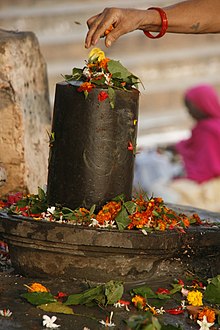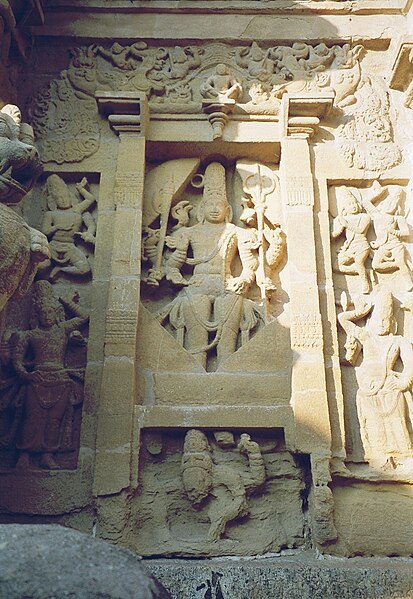Un article de Wikipédia, l'encyclopédie libre.
Omphalos signifie ombilic en grec ancien.
Mythologie
Selon la cosmogonie de la religion grecque antique, Zeus aurait lâché deux aigles des points extrêmes oriental et occidental du monde. Au point où ils se rencontrèrent, Zeus aurait laissé tomber l'omphalos, marquant ainsi le centre, le « nombril du monde ». Plusieurs omphalos furent érigés durant l'antiquité à travers le bassin méditerranéen mais le plus célèbre est celui de l'oracle de Delphes, pierre de forme conique, directement placée dans l'adyton du temple oraculaire d'Apollon, entourée de tissu et surmontée de deux aigles en or. La tradition situait la tombe du Python vaincu par Apollon sous l'omphalos.
L’omphalos serait une pierre substituée à Zeus nouveau-né et avalée par Cronos. Elle symbolise ainsi la naissance de Zeus et sa puissance. La légende veut que Cronos, ayant appris qu’un jour un de ses fils le détrônerait, exigeait de sa femme Rhéa qu’elle lui livre chaque nouveau né, qu’il engloutissait aussitôt. Elle réussit à éviter ce sort à son sixième enfant en lui substituant une pierre enveloppée d'un linge. Plus tard, devenu adulte, Zeus, aidé de sa grand-mère Gaïa, força son père à dégorger la pierre et les enfants précédemment avalés, qui devinrent les dieux de l'Olympe.
« Ce que les habitants de Delphes appellent omphalos est en fait en pierre blanche et considéré comme se trouvant au centre de la terre, et Pindare, dans une de ses odes, confirme cette opinion. »
(Pausanias, Description de la Grèce
Autres significations
- Chez Platon, le nombril est la cicatrice laissée par le châtiment divin, mutilation qui nous a séparés d’une part de nous mêmes (châtiment des hermaphrodites dans le Banquet).
- Selon le « dogme de l’anomphalie » (ou anomphalisme) débattu par les théologiens juifs dès le Moyen Âge, Adam et Ève seraient dépourvus de l’ombilic car ils n’avaient pas de mères qui auraient accouché d’eux. Le peintre Jean-Baptiste Santerre en était un grand partisan. À partir du XVIIIe siècle, l’Église chrétienne se prononça en faveur de l’omphalisme mais les créationnistes actuels reprennent ce dogme à la lettre. Il est à noter que dans le chapitre 35 de l’Évangile de Barnabé, Jésus raconte que le nombril d’Adam est la trace du crachat de Satan sur la glaise dont Dieu se servit pour façonner le premier homme.
Un article de Wikipédia, l'encyclopédie libre
Trois têtes de Shiva, le Gandhara, 2ème siècle après JC

Shiva with Parvati . Shiva avec Parvati . Shiva is depicted three-eyed, the Ganges flowing through his matted hair (which are yellowish-white or like molten gold), wearing ornaments of serpents and  a skull bracelet, and covered in ashes, and Trisula and Damaru are seen in the background. Shiva est représenté à trois yeux, l' Gange qui coule à travers ses cheveux emmêlés (qui sont d'un blanc jaunâtre ou comme de l'or en fusion), portant des ornements de serpents et un bracelet crâne, et couvert de cendres, et triçûla et Damaru sont vus dans l'arrière-plan.
a skull bracelet, and covered in ashes, and Trisula and Damaru are seen in the background. Shiva est représenté à trois yeux, l' Gange qui coule à travers ses cheveux emmêlés (qui sont d'un blanc jaunâtre ou comme de l'or en fusion), portant des ornements de serpents et un bracelet crâne, et couvert de cendres, et triçûla et Damaru sont vus dans l'arrière-plan.
- Shiva's form: Shiva has a Trident in the right lower arm, with a crescent moon on his head. Sous forme de Shiva: Shiva a un Trident dans le bras inférieur droit, avec un croissant de lune sur sa tête. He is said to be fair like camphor or like an ice clad mountain. Il
http://translate.google.be/translate?hl=fr&sl=en&u=http://en.wikipedia.org/wiki/Om_Namah_Shivaya&ei=S39lT8-lAc-y8QP87eWhBg&sa=X&oi=translate&ct=result&resnum=1&sqi=2&ved=0CDsQ7gEwAA&prev=/search%3Fq%3Dshivaya%26hl%3Dfr%26qscrl%3D1%26nord%3D1%26rlz%3D1T4GGLL_frBE364BE364%26biw%3D1089%26bih%3D566%26site%3Dwebhp%26prmd%3Dimvnsa

Shiva bearing the descent of the Ganges River as Parvati and Bhagiratha and the bull Nandi look, folio from a Hindi manuscript by the saint Narayan, circa 1740 Shiva portant la descente du Gange et de Parvati Bhagiratha et le regard taureau Nandi, folio d'un manuscrit Hindi par le Narayan saint, vers 1740
- Nandi: Nandi , également connu sous le nom Nandin, est le nom de la bulle qui sert de monture de Shiva (sanskrit: vahana ). [98] [99] association de Shiva avec le bétail se reflète dans son nom, Pasupati ou Pashupati (en sanskrit: पशुपति) , traduit par Sharma comme «seigneur de bétail» [100] et par Kramrisch comme «seigneur des animaux", qui note qu'il est particulièrement utilisé comme une épithète de Rudra. [101] Rishabha ou le taureau représente Dharma Devata. Lord Siva rides on the bull. Seigneur Shiva chevauche le taureau. Bull is his vehicle. Bull est son véhicule. This denotes that Lord Siva is the protector of Dharma, is an embodiment of Dharma or righteousness. Cela dénote que le Seigneur Shiva est le protecteur du dharma, c'est un mode de réalisation du Dharma ou la justice.

An illustration of the family of Shiva, consisting of Shiva, Parvati , Ganesha and Skanda (Kartikeya) Une illustration de la famille de Shiva, constitué de Shiva, Parvati , Ganesh et Skanda (Kartikeya)
He is depicted as both an ascetic yogin and as a householder, roles which have been traditionally mutually exclusive in Hindu society. [ 122 ] When depicted as a yogin, he may be shown sitting and meditating. [ 123 ] His epithet Mahāyogin ("the great Yogi : Mahā = "great", Yogin = "one who practices Yoga ") refers to his association with yoga. [ 124 ] While Vedic religion was conceived mainly in terms of sacrifice, it was during the Epic period that the concepts of tapas , yoga , and asceticism became more important, and the depiction of Shiva as an ascetic sitting in philosophical isolation reflects these later concepts. [ 125 ] Il est représenté à la fois comme un ascète yogi et comme un chef de ménage, des rôles qui ont été

http://translate.google.be/translate?hl=fr&sl=en&u=http://en.wikipedia.org/wiki/Om_Namah_Shivaya&ei=S39lT8-lAc-y8QP87eWhBg&sa=X&oi=translate&ct=result&resnum=1&sqi=2&ved=0CDsQ7gEwAA&prev=/search%3Fq%3Dshivaya%26hl%3Dfr%26qscrl%3D1%26nord%3D1%26rlz%3D1T4GGLL_frBE364BE364%26biw%3D1089%26bih%3D566%26site%3Dwebhp%26prmd%3Dimvnsa

Traditional flower offering to a Lingam in Varanasi Offrande florale traditionnelle à un Lingam dans Varanasi
The Lingam (also, Linga , Ling , Shiva linga , Shiv ling , Sanskrit लिङ्गं liṅgaṃ , meaning "mark", "sign", "gender", "phallus", "inference" or "eternal procreative germ" [ 1 ] [ 2 ] ) is a representation of the Hindu deity Shiva used for worship in temples . [ 3 ] Le Lingam (également, Linga, Ling, Shiva linga, Shiv Ling, le sanskrit लिङ्गं lingam, ce qui signifie «marque», «signe», «genre», «phallus», la «déduction» ou «éternelle germe procréateur» [1] [2 ] ) est une représentation de l' Hindu divinité Shiva utilisé pour le culte dans les temples .

Sivalingam at the Sri Meenakshi temple in Madurai Sivalingam au temple Sri Meenakshi à Madurai
The Sanskrit term लिङ्गं liṅgaṃ , transliterated as linga , has diverse meaning ranging from gender and sex to philosophic and religions to uses in common language, such as a mark, sign or characteristic. Le sanscrit terme लिङ्गं lingam, la translittération linga, a une signification variée allant de genre et du sexe pour


A 10th century four-headed stone Lingam from Nepal Un 10e siècle à quatre têtes de pierre Lingam du Népal
According to Saiva Siddhanta , which was for many centuries the dominant school of Shaiva theology and liturgy across the Indian subcontinent (and beyond it in Cambodia), the linga is the ideal substrate in which the worshipper should install and worship the five-faced and ten-armed Sadāśiva, the form of Shiva who is the focal divinity of that school of Shaivism. [ 14 ] Selon Saiva Siddhanta , qui fut pendant plusieurs siècles l'école dominante de la théologie et la liturgie Shaiva à travers le

The omphalos in museum of Delphi.
Most accounts locate the Omphalos in the temple adyton near the Pythia. The stone itself (which may have
In the Church of the Holy Sepulchre in Jerusalem there is also an omphalos. The existence of this stone is based upon the medieval cosmology which saw Jerusalem as the spiritual if not geographical center of the world (see T and O map). This tradition is likely based on an ancient Jewish tradition that saw Jerusalem as the navel of the world.[1]
In the Jewish tradition, the Ark in the Temple in Jerusalem, through which God revealed himself to His people, rested on the Foundation stone marking the "navel of world". (This Jewish tradition is known to have begun in Hellenistic times, when Jews were already quite familiar with Greek culture - and thus, might be a deliberate emulation of and competition with the above tradition regarding Delphi).
http://en.wikipedia.org/wiki/Omphalos

http://en.wikipedia.org/wiki/Foundation_Stone
Suite !!